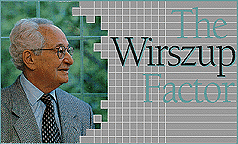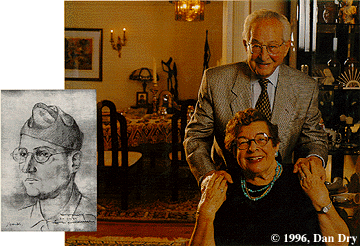
The University of Chicago Magazine
October-December 1996

Continued

Portraits of Izaak: With Pera Wirszup (right) in their Kenwood Avenue apartment; a wartime sketch (left), done by a fellow prisoner.
Making a difference, Izaak Wirszup believes, is what he was meant to do. Attributing the fact that he survived one year and eight months in a series of six concentration camps to the kindness shown him by fellow prisoners, Wirszup explains, "When I remained alive, the sole survivor of a very large family, I had to confirm in my own conscience and before the memory of all my dear ones that I was doing something valuable--something truly good--and doing it to the best of my abilities, with a life that had been spared me completely by chance."
Growing up in what was then Wilno, Poland, Wirszup learned the value of hospitality and charity from his parents. The city was a hub of Jewish culture, and Wirszup's father, a prosperous candy manufacturer, was an avid patron of the arts, often inviting artists, writers, and others into the family home. "We were five at home, but we always had ten people at the dinner table," Wirszup recalls. "There were always guests, and the maids told us they didn't expect to have to serve so many people when they came to work for us."
A gifted student, Wirszup pursued a career in mathematics and studied at the University of Wilno under Antoni Zygmund, an internationally famous math scholar who later joined the wave of Eastern European academics emigrating to the U.S. in the early days of World War II.
When Germany invaded Poland in 1939,Wirszup, a lecturer in mathematics at the State Technical Institute, stayed on in Wilno with his wife, Pola, and their infant son. In 1941, they were detained in the city's ghetto. In the summer of 1943, he was separated from his family and sent to a concentration camp in Estonia, near Tallinn. Moved from camp to camp, he eventually became one of 1,000 Jews from Wilno sent to a German camp near the Swiss border, where they were put to work building underground factories to make gasoline from local coal. "We worked up to our knees in mud," he later recalled, "utterly exhausted, and suffering from severe malnutrition." Within nine months, fewer than 100 of the 1,000 men remained alive: "I was a month before dying."
A graveyard saved him. Digging for coal, the prisoners discovered a 2,000-year-old burial ground--an archaeological find that captured the interest of an SS captain who needed educated prisoners to help with the excavations. Wirszup, who had told the Germans he was a house painter, was put to work sketching the site.
When the ground became too frozen to dig, he was transferred to yet another camp in November 1944. At Erzingen, he was quartered with political prisoners, leaders of the European resistance who had been sentenced to death. What struck Wirszup most forcibly was that these men, though living in a nightmare, were still capable of the same courtesy that his father had shown the family's guests in their pre-war prosperity.
Very ill when he arrived at Erzingen, Wirszup was surprised and grateful when his fellow prisoners helped him wash. "After my first night," he recalls, "they asked me, 'Avez-vous bien dormi?'"
In the final days of the war, Wirszup and the resistance fighters were transferred to the camp at Allach-Dachau, where they were liberated by General Patton's army. Turning down an offer to go to France with a fellow prisoner, he returned home, only to learn that his wife and son had both died in a camp and that his parents, brother, and sister, despite managing to escape detainment in the ghetto, had been quickly discovered in a small village and killed: "All of them, gone. But then, there, in Wilno, I found Pera."
A friend from his childhood, she had been widowed in the war, but had survived the camps with her daughter, Marina. Together, they made their way to Paris, where Wirszup reconnected with the friends he had made in Erzingen. One of those men, the owner of the department-store chain Galeries Lafayette, offered him a job as director of research and found the family a home in a chateau outside the city.
He might have stayed in Paris, becoming, like his father before him, a successful businessman. But Antoni Zygmund, who had made his way from MIT to Chicago's math department, wrote him, stating simply, "Izaak, it is time." That crisp recall to his academic past brought Wirszup and his family across the Atlantic and to the quads in the autumn of 1949.
If the Wirszups were leaving one set of associates, it was only to begin forging another close circle of ties. As
he went about establishing himself as the nation's top authority on math education outside the United States, Wirszup also set a standard for service to the U of C community, winning a Quantrell award for excellence in undergraduate teaching in 1958 and, with Pera, serving as a resident master of Woodward Court from 1971 through 1985. As masters, they pioneered the tradition of bringing faculty and students together in a lecture program that drew hundreds and featured such notable thinkers as John Hope Franklin. That tradition continues with the Izaak Wirszup Lecture Series, endowed by a former student. Wirszup was also honored in 1994 with the Alumni Service Medal for extended, extraordinary service to the University.
From the time the Wirszups first came to Chicago through their stay in Woodward Court and now in their book-lined Kenwood Avenue apartment, just a few blocks from the quads, their home has radiated cheerfulness. As they greet old friends and students who return for a visit, their habit of hospitality, learned by example in times of both prosperity and adversity, continues. For their visitors, there is the real pleasure of being guests of Izaak and Pera, hosts who take an interest in one's life and family as well as in one's research. For the Wirszups, there is real pleasure, too.
"Pera and I have seen firsthand the desecration of life," Izaak Wirszup told the crowd of colleagues, students, and alumni who gathered on the occasion of his retirement. "We have witnessed the organized annihilation of millions of innocent, wonderful human beings. We have seen giants collapse--morally and physically--within days, when subjected to inhuman conditions. But we have also encountered people who would make any sacrifice, heroes whose like we had seen before only in the scriptures. We have seen how love, friendship, and help can transform the most fragile souls into individuals stronger than steel."
Return to "The Wirszup Factor"
Sidebar: "Large Numbers on Campus," about the U of C School Mathematics Project
Go to:
- INVESTIGATIONS
- CHICAGO JOURNAL
- EVENTS
- LETTERS
- CHICAGOPHILE
- Feature story, "The Strange Laboratory of Dr. LaBarbera"
- Feature story, "Strength in Numbers"
- Special Report, "Building a Strong Cornerstone"
- Feature story, "The Wirszup Factor"
- CLASS NEWS
- DEATHS
- BOOKS BY ALUMNI
- IN THE CLUBS
Return to October-December 1996 Table of Contents